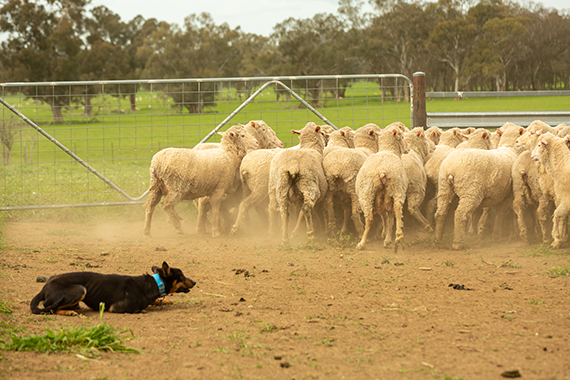Worm dogs to prevent hydatids in flock & family
 PRODUCTION ADVICE - FEBRUARY 2021 - ANIMAL BIOSECURITY & WELFARE
PRODUCTION ADVICE - FEBRUARY 2021 - ANIMAL BIOSECURITY & WELFARE
By Brianna Henman
Veterinary student
Charles Sturt University
 A recent post-mortem of a sheep in the Murray region revealed hydatid cysts. Hydatid cysts come from infection with the hydatid tapeworm (Echinococcus granulosis). This tapeworm is most common in sheep farming areas, due to the relationship between working dogs, stock and humans. This highlights just how important it is for producers to understand the lifecycle of the parasite and how to prevent infection on their farm.
A recent post-mortem of a sheep in the Murray region revealed hydatid cysts. Hydatid cysts come from infection with the hydatid tapeworm (Echinococcus granulosis). This tapeworm is most common in sheep farming areas, due to the relationship between working dogs, stock and humans. This highlights just how important it is for producers to understand the lifecycle of the parasite and how to prevent infection on their farm.
Intermediate hosts (sheep)
Once the pasture becomes contaminated with infected dog faeces, the sheep can become infected by consuming the pasture. The tapeworm eggs that have been ingested by the sheep hatch and travel via the bloodstream to liver, lungs and other organs, where hydatid cysts are formed.
Definitive hosts (dogs)
Infection in dogs occurs when they consume meat or bodily fluids from intermediate hosts containing hydatid cysts. These cysts then burst, allowing the tapeworm to travel to the intestines. Once mature inside the intestine of the dog, the hydatid tapeworm releases eggs into the environment via the faeces.
Humans are infected in a similar way to sheep, via ingestion of tapeworm eggs, allowing formation of hydatid cysts in organs. The ingestion does not necessarily occur from accidently consuming dog faeces, but more commonly from the eggs attached to the coat of infected dogs, which are consumed after patting the animal. Human infection is most common in people with close association to dogs and those practicing poor hygiene.
Once sheep are infected, although they do not present clinically with disease, there is no treatment. At the abattoir, if an animal is suspected to have hydatid cysts within the offal, the affected organs are condemned. The risk to public health is by far the most concerning impact of this disease. Hydatid disease in humans is very serious and has proven to be fatal. Even with surgery to remove hydatid cysts, secondary complications commonly occur.
Therefore, effective control of hydatid tapeworms in dogs is the best way to prevent infection in intermediate hosts, including sheep and humans.
Prevention
There are several easy preventative measures to ensure your farm does not become infected with hydatid tapeworms.
- Deworm any dogs on the property every six weeks with a wormer containing praziquantel. This can be put in food for easy administration.
- Do not allow dogs access to dead stock or feed them fresh offal, as this increases the chance of consuming hydatid cysts. To reduce scavenging, dogs can be restrained in a run, kennel or on leads while not working. Dispose of dead stock quickly to reduce access. Manufactured dog food has no risk of tapeworm contamination due to the processing method and is the best option to feed to working dogs.
- Practice good hygiene. Ensure everyone, especially children, thoroughly washes their hands after playing with dogs to minimise the risk of ingested tapeworm eggs. Also, prevent dogs from urinating and defecating near areas such as outside play areas and veggie patches.
Just by worming your working dogs every six weeks, you are protecting both your livestock and yourself from ingesting tapeworm eggs and contracting hydatid disease. Sounds like a favourable outcome for everyone!